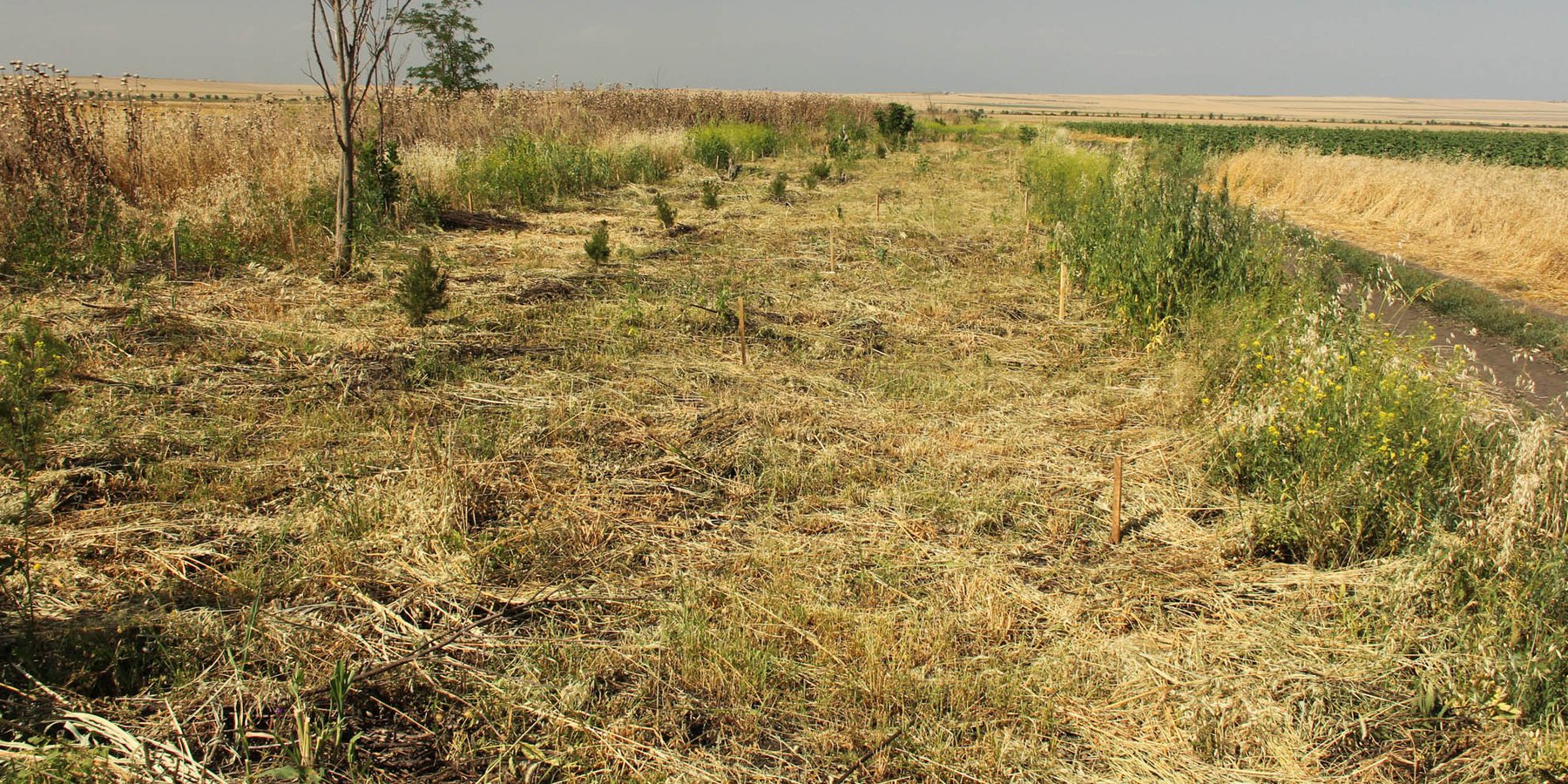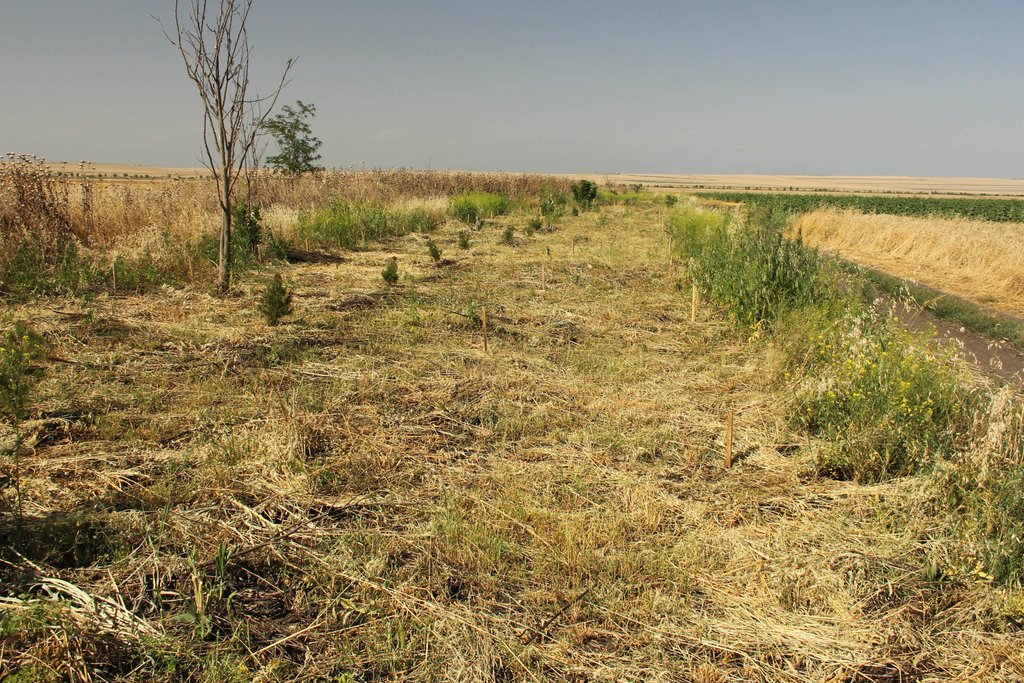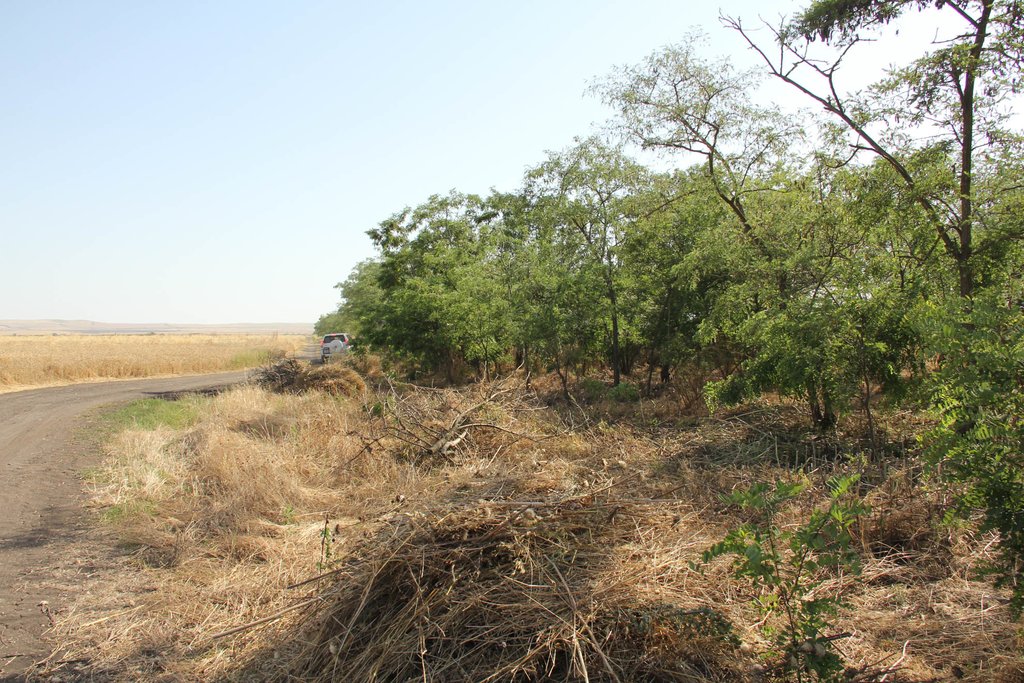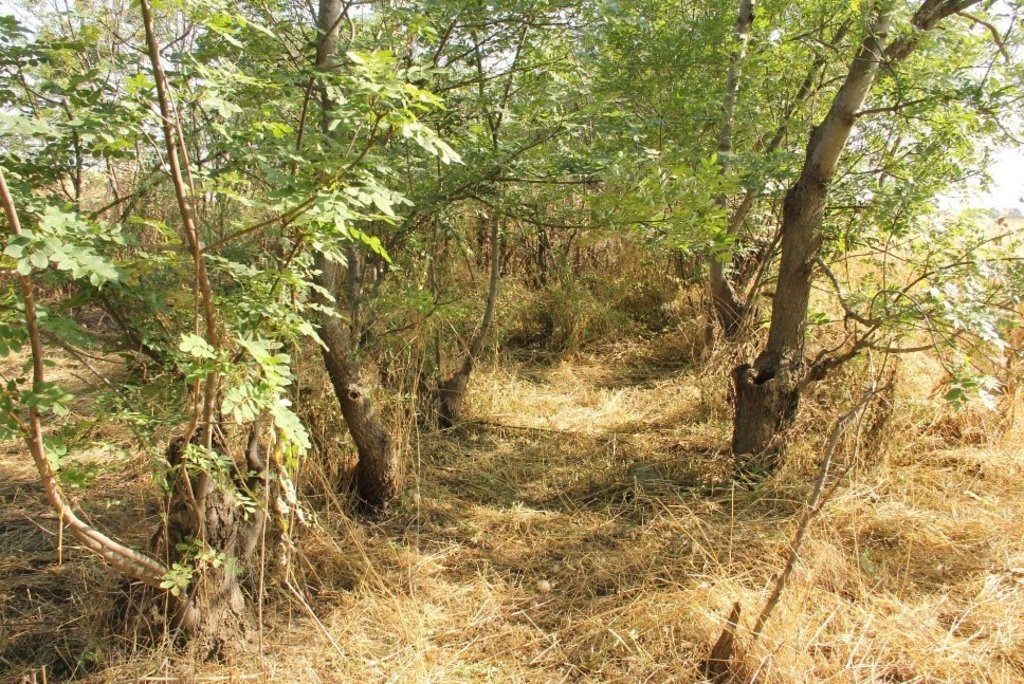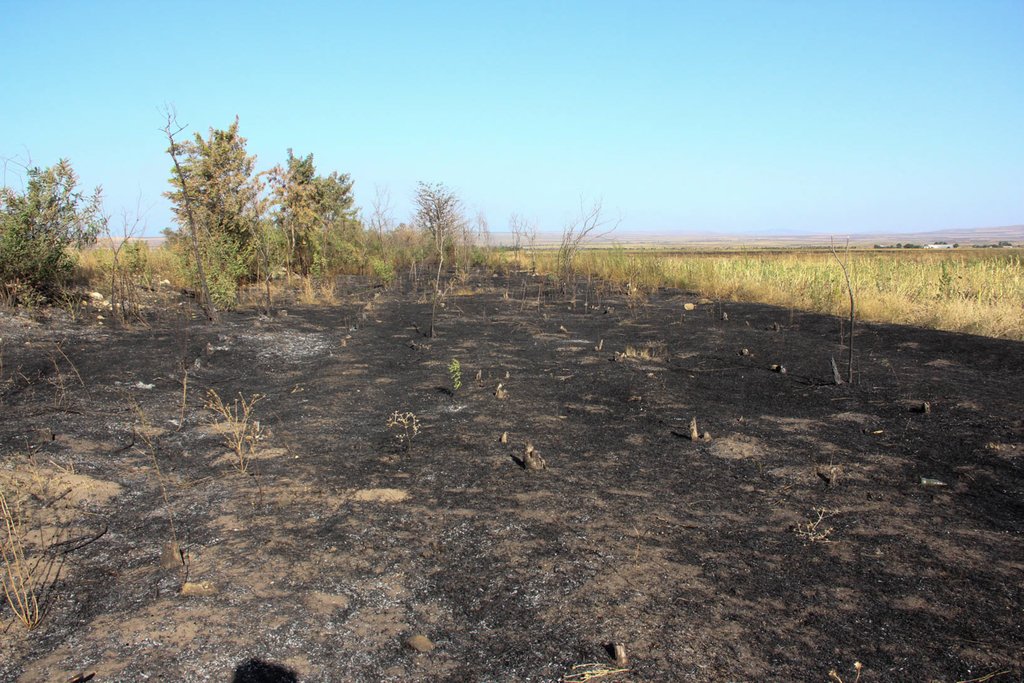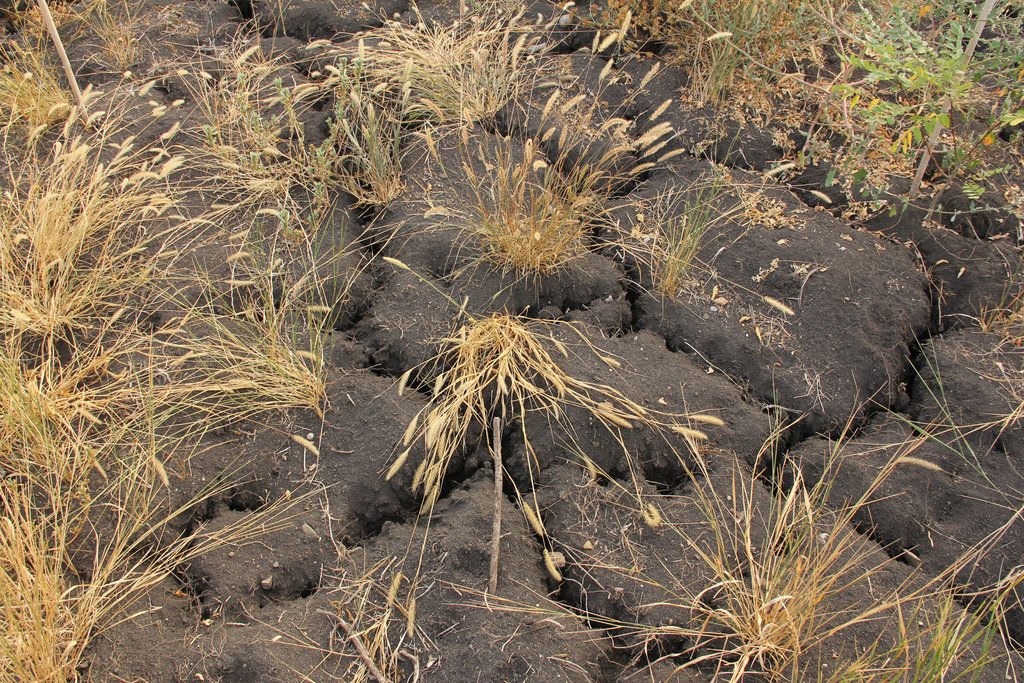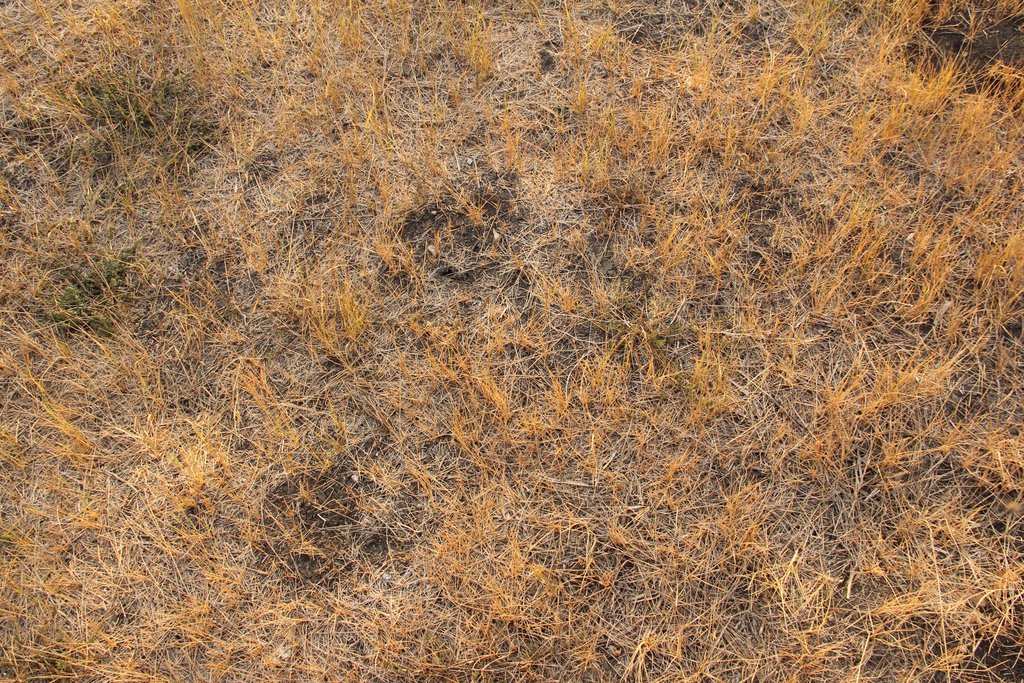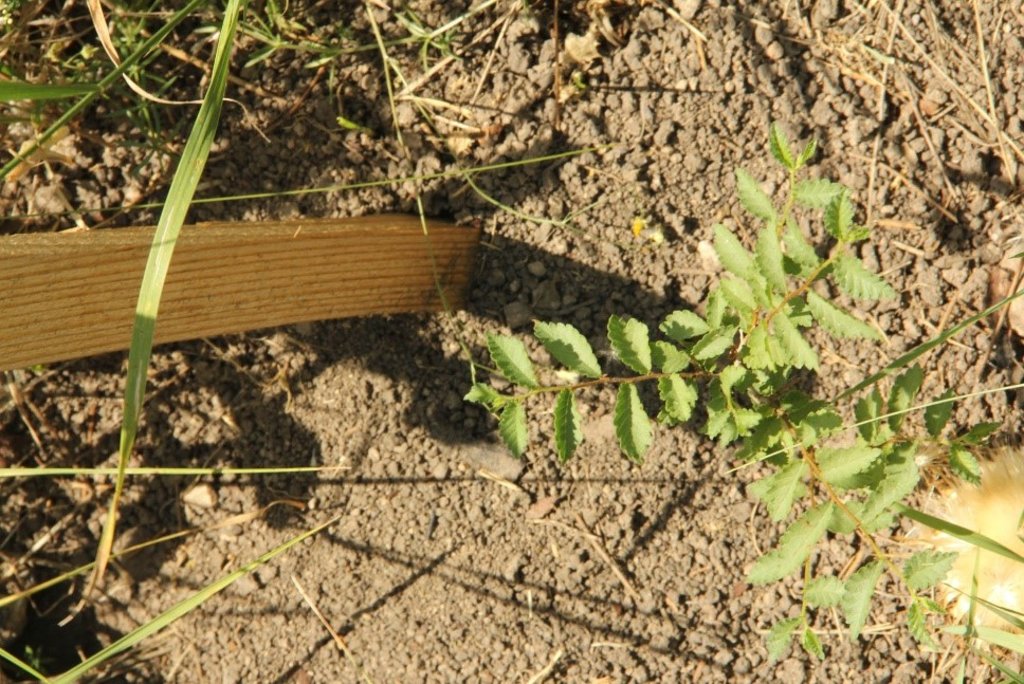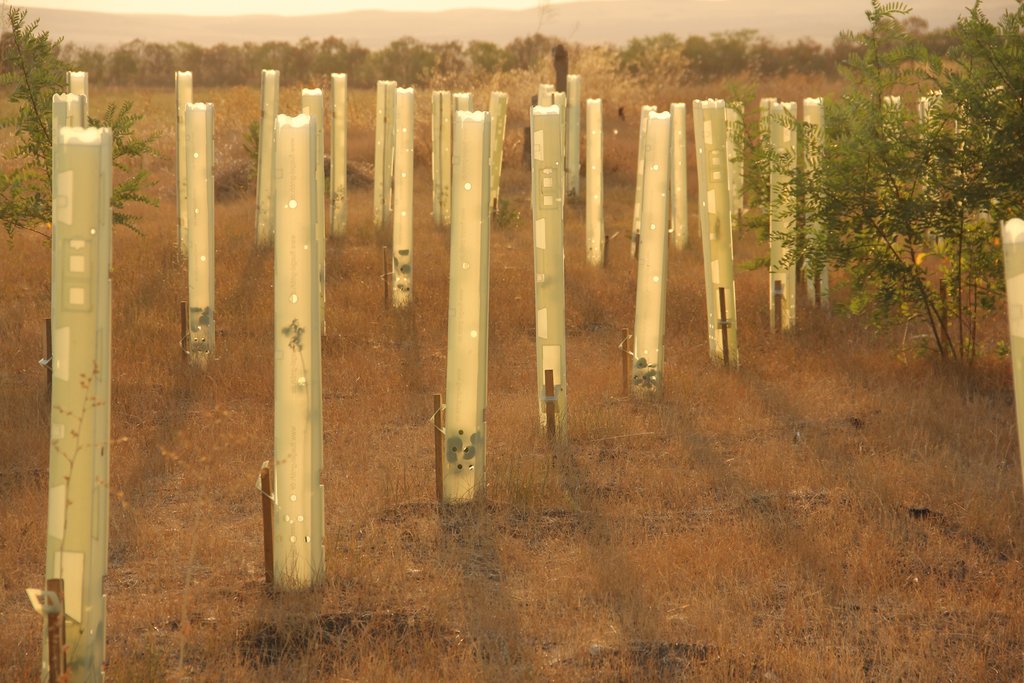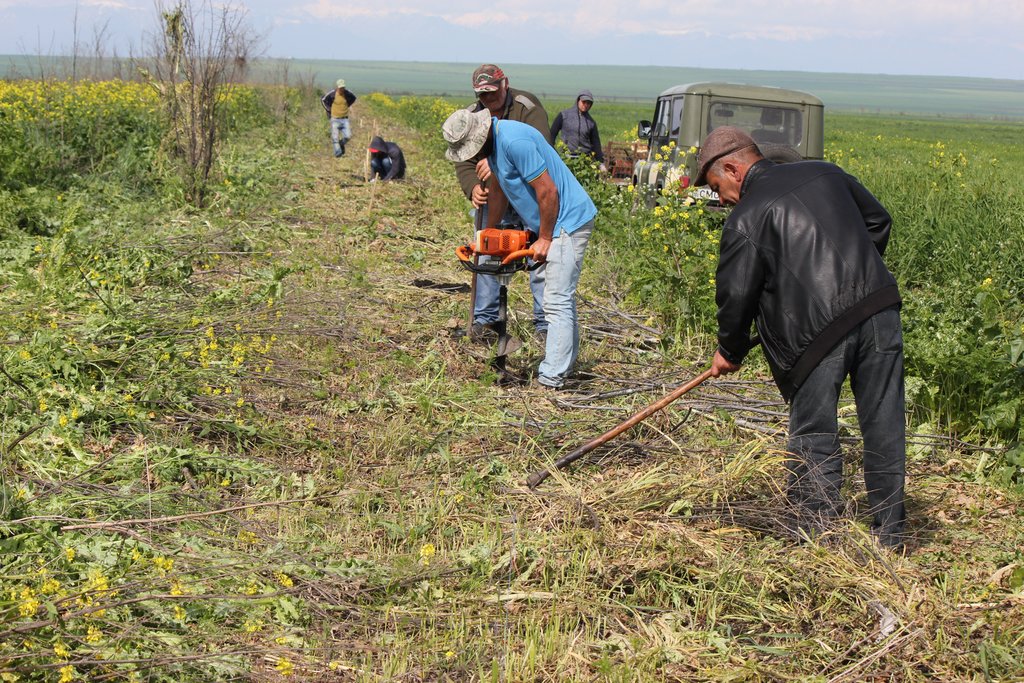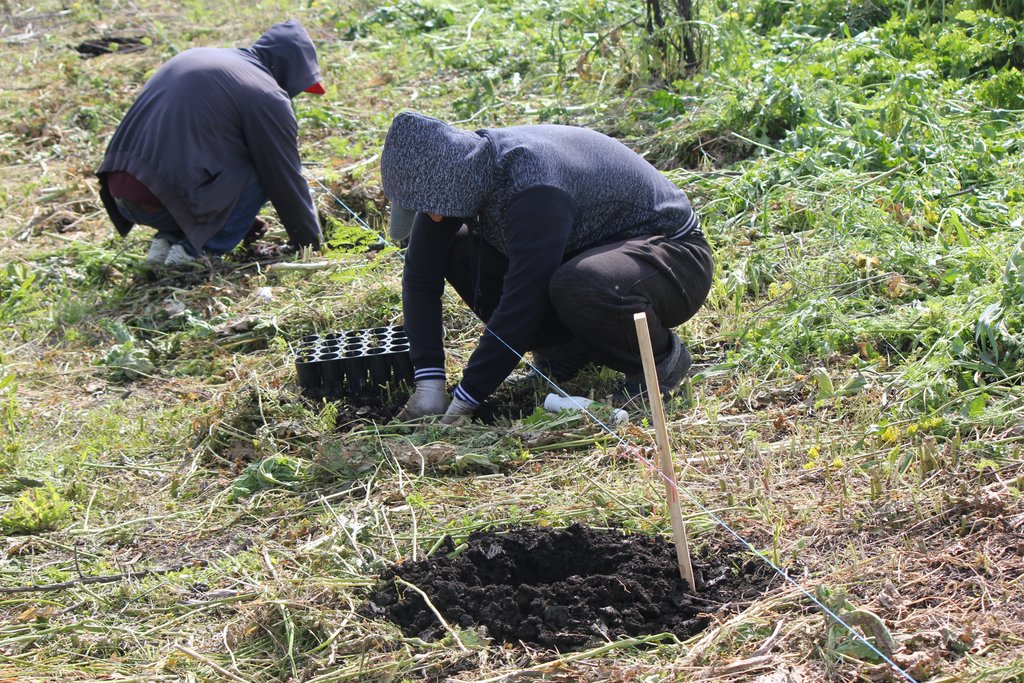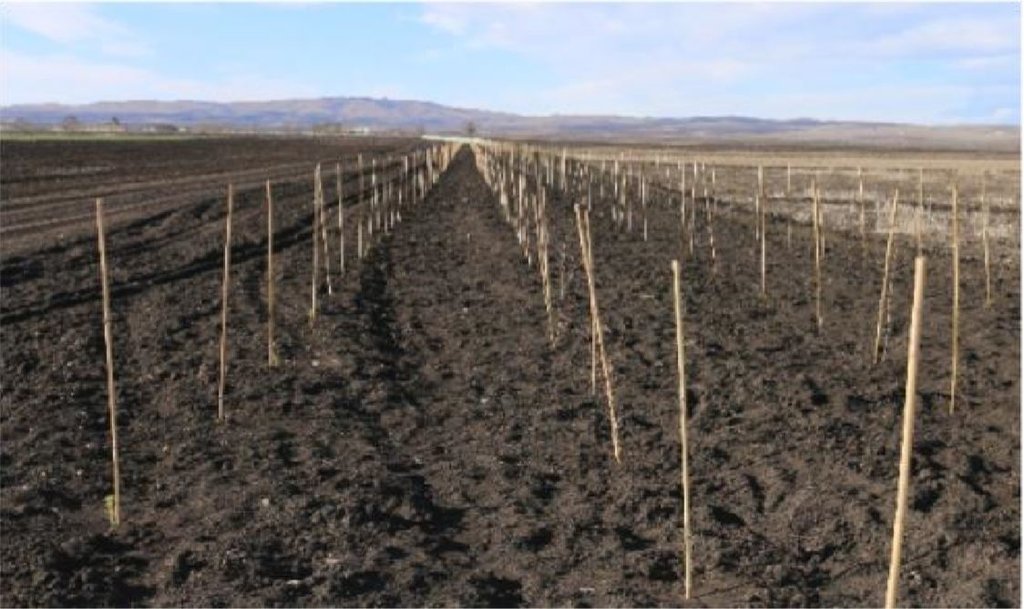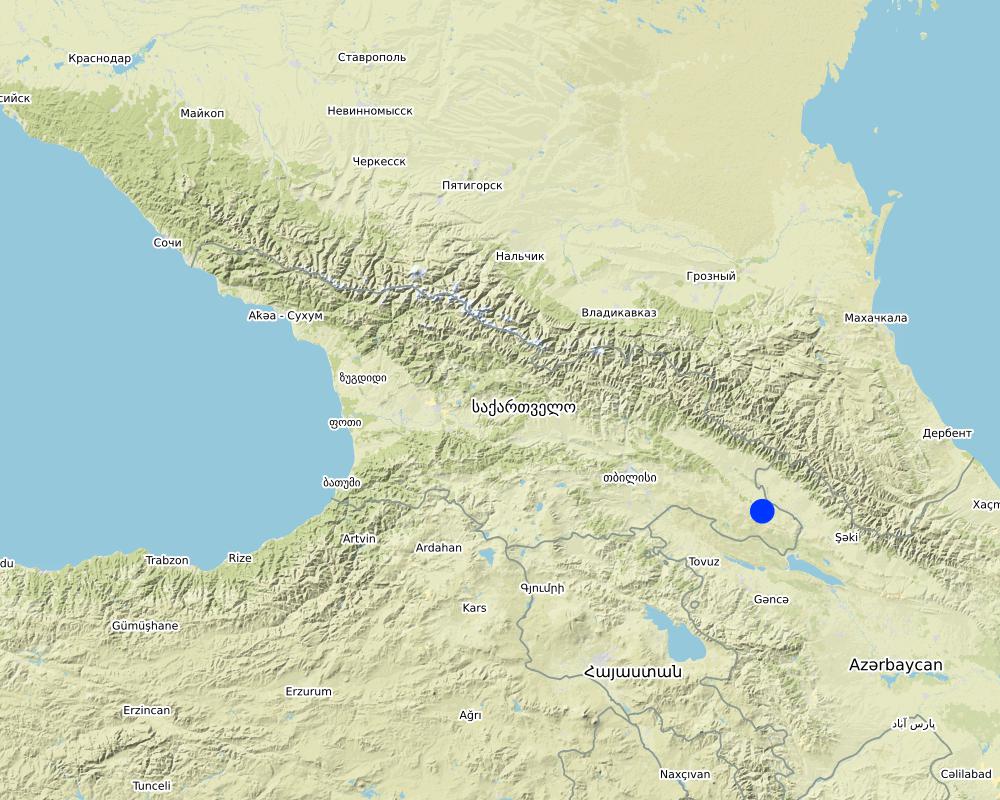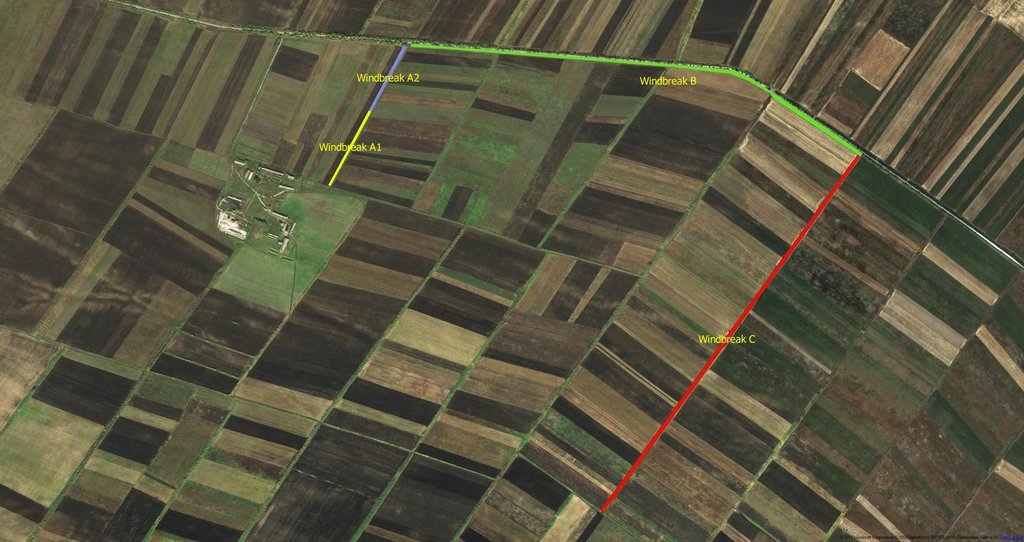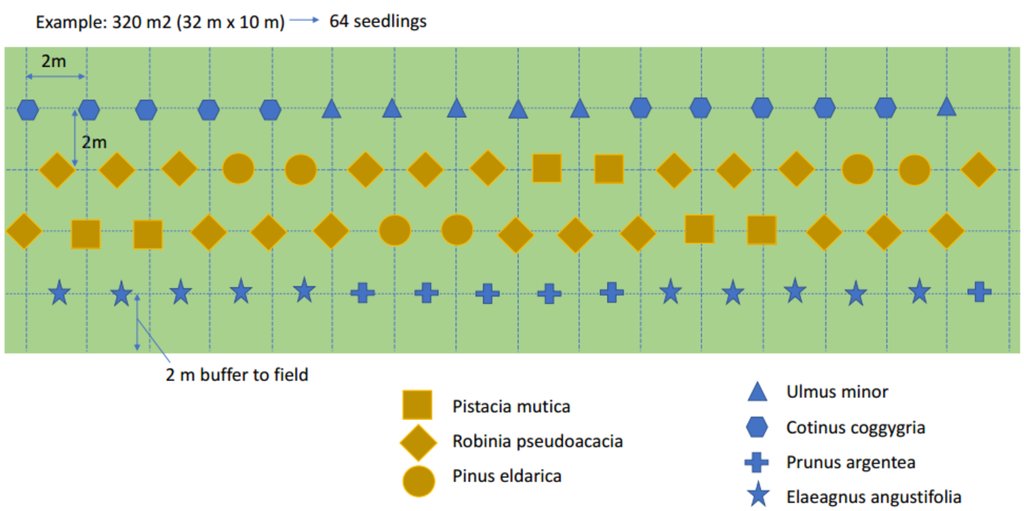Rehabilitation of Windbreaks [Georgia]
- Creación:
- Actualización:
- Compilador: Hanns Kirchmeir
- Editor: Kety Tsereteli
- Revisor: Rima Mekdaschi Studer
technologies_4274 - Georgia
Visualizar secciones
Expandir todo Colapsar todos1. Información general
1.2 Detalles de contacto de las personas de referencia e instituciones involucradas en la evaluación y la documentación de la Tecnología
co-compiler:
co-compiler:
co-compiler:
Nombre del proyecto que financió la documentación/ evaluación de la Tecnología (si fuera relevante)
Applying Landscape and Sustainable Land Management (L-SLM) for mitigating land degradation and contributing to poverty reduction in rural area (L-SLM Project)Nombre de la(s) institución(es) que facilitaron la documentación/ evaluación de la Tecnología (si fuera relevante)
Regional Environmental Centre for the Caucasus (REC Caucasus) - GeorgiaNombre de la(s) institución(es) que facilitaron la documentación/ evaluación de la Tecnología (si fuera relevante)
Deutsche Gesellschaft für Internationale Zusammenarbeit (GIZ)1.3 Condiciones referidas al uso de datos documentados mediante WOCAT
El compilador y la/s persona(s) de referencia claves aceptan las condiciones acerca del uso de los datos documentados mediante WOCAT:
Sí
1.4 Declaración de la sostenibilidad de la Tecnología descrita
¿La Tecnología aquí descrita resulta problemática en relación a la degradación de la tierra, de tal forma que no puede considerársela una tecnología sostenible para el manejo de la tierra?
No
2. Descripción de la Tecnología MST
2.1 Breve descripción de la Tecnología
Definición de la Tecnología:
Windbreaks are an integrated technology to increase land productivity and biodiversity at different levels. Along six kilometres, located between a road and agricultural fields, windbreaks were rehabilitated or newly established to protect the soil wind erosion. Four lines of seedlings including seven tree species were planted in two meters distance to each other. The survival rates of different tree species have been accessed and evaluated.
2.2 Descripción detallada de la Tecnología
Descripción:
Agriculture plays a key role in the economy of Georgia. 74% of wheat is produced in Kakheti. Within the region, the main wheat-growing area is Shiraki valley located in Dedoplistskaro Municipality in Eastern Georgia. The valley has deep soil with high humus content offering significant potential for high agricultural yields. Among others, wind erosion and increase of evaporation due to degradation of windbreaks have led to reduced agricultural yields. At the end of the Soviet Union, there were 1.800 km of tree windbreaks in Shiraki. More than 90% of them were destroyed either by fire or illegal cuttings for firewood. Fires are caused by farmers burning harvest residues and by shepherds burning pastures and windbreaks to facilitate the growth of new grass and clear land. Today, fire still pose the greatest threat to the rehabilitation of windbreaks. Grazing by migrating sheep and by local (cattle) herds as well as firewood extraction is still causing additional damage to windbreaks in specific areas of Shiraki valley.
In Dedoplistskaro, the SLM-pilot activities focus on the establishment of a windbreak/agroforestry system to reduce wind erosion, which is here the main degradation factor and threatens agricultural production. Windbreaks are a well-known measure against wind erosion. They consist of several rows of trees and bushes on the edges of agricultural fields to reduce the wind-speed on the surface level. Slowing down of wind-speed protects the topsoil from wind erosion. Windbreaks improve the micro-climate for crops growing in their shelter by reducing moisture loss. Windbreaks also provide shelter and habitats for a wide range of plants, pollinating insects, wildlife and birds, including predators of agricultural pests.
Selection of seedlings:
Tree species well adapted to the regional conditions (climate, soil, etc.) were selected such as Pinus (Pinus eldarica, survival rate: 90%), Pistacia (Pistacia mutica, survival rate 60%) and Elm (Ulmus minor, survival rate 60%), Wild Almond (Prunus argentea, survival rate 40%), Persian olive (Eleagnus angustifolia, survival rate: 40%) and Robinia (Robinia pseudoacacia, survival rate 16%). The survival rates are based on the assessment in September 2018, 6 months after planting.
The seeds were prepared for planting in a nursery. Seedlings to be transported over long distances must be grown in special containers to ensure good root system development and minimise damage during transport. If they are grown near the planting site and the transport time is short, seedlings may also be bare-rooted.
Preparation of soil and planting:
The pilot site of the project "Applying Landscape and Sustainable Land Management (L-SLM) for Mitigating Land Degradation and Contributing to Poverty Reduction in Rural Areas", implemented by the Regional Environment Centre for the Caucasus, is six km long and located on the main road on state-owned land. Before planting the seedlings, the vegetation (grass and herbs) was cut and removed. No ploughing was done. During the implementation in 2018, the design of the site was changed to a 6 km long U-shaped form with three 10 m wide segments of windbreaks. The total area of the pilot site is 6 ha, but since there were already intact hedges in some parts, the total area where windbreaks were either newly planted or rehabilitated is 3 ha. Each windbreak consisted of four lines of tree seedlings of different species in two meters distance to each other (inter-row spacing) and 2 m distance between the seedlings within a row (intra-row spacing). First, holes were dug (30 cm diameter, 40 cm deep), then water accumulation granulate was added to keep the water better, then the seedlings of 10-40 cm height and 2-3 years old depending on species were inserted. No compost or fertiliser was used. The seedlings were protected by plastic tubes from the cold and dry winter season. Every 2nd seedling was marked with a wooden pole to distinguish them from weeds and to control the survival rate. If the survival rate falls below 50%, the trees should be replaced. After the planting of the seedling, the herbs and grass were cut again. Further cuttings took place several times to avoid shading and competition.
Maintenance
Besides cutting of weeds for 2 times in the main growing season (Mai-July) regular watering was applied. Young seedlings should be watered 2-4 times per year (first 2 years) – about 15-20l per tree. After 2 years the root system should be established in such a way that it can take care of itself. The implementation area was not fenced, but there is no pastureland around and pressure by browsing is low.
The Regional Environment Centre for the Caucasus (REC) in cooperation with GIZ has conducted a cost-benefit analysis to estimate the value of protecting remaining windbreaks, the economic impact of banning crop residue burning and the benefits of straw as a fertilizer. The survey data shows that a ban on crop residue burning will help to protect the existing windbreaks. Consequently, shredding of straw during the harvest and subsequent incorporation of straw into the soil builds up soil organic matter and helps to retain the moisture in the ground. Unclear ownership and institutional responsibility are the most relevant constraints for sustainable windbreaks management as a measure. At the political level, issues were noted, and steps were taken: A working group under the National Forest Programme selected windbreaks restoration and protection as their key topics. The Ministry of Environmental Protection and Agriculture with the support from REC and GIZ developed a policy for rehabilitation and protection of windbreaks. Based on this, a new law on windbreaks was initiated which will clarify the situation by ascribing clear responsibilities on windbreak maintenance and management. This law is still at the stage of preparation in the Agrarian Committee.
2.3 Fotografías de la Tecnología
2.5 País/ región/ lugares donde la Tecnología fue aplicada y que se hallan comprendidos por esta evaluación
País:
Georgia
Región/ Estado/ Provincia:
Kakheti
Especifique más el lugar :
Dedoplistskaro
Especifique la difusión de la Tecnología:
- aplicada en puntos específicos/ concentrada en un área pequeña
¿El/los sitio(s) de la Tecnología se ubica(n) en un área de protección permanente?
No
Comentarios:
The intervention was done along the main road and along two side roads heading south.
Map
×2.6 Fecha de la implementación
Indique año de implementación:
2018
2.7 Introducción de la Tecnología
Especifique cómo se introdujo la Tecnología:
- mediante proyectos/ intervenciones externas
Comentarios (tipo de proyecto, etc.):
The rehabilitation of the windbreaks was tested on a pilot site along a highly visible road within the project "Applying Landscape and Sustainable Land Management (L-SLM) for Mitigating Land Degradation and Contributing to Poverty Reduction in Rural Areas" implemented by the Regional Environment Centre for the Caucasus (REC).
3. Clasificación de la Tecnología MST
3.1 Propósito(s) principal(es) de la Tecnología MST
- mejorar la producción
- reducir, prevenir, restaurar la degradación de la tierra
- preservar/ mejorar biodiversidad
3.2 Tipo(s) actuales de uso de la tierra donde se aplica la Tecnología
Mezcla de tipos de uso de tierras dentro de la misma unidad de tierras: :
Sí
Especifique el uso combinado de tierras (cultivos/ pastoreo/ árboles):
- Agroforestería

Tierras cultivadas
- Cosecha anual
Cosechas anuales - Especifique cultivos:
- cereales - cebada
- cereales - trigo (verano)
- cereales - trigo (invierno)
Número de temporadas de cultivo por año:
- 2
¿Se practica el intercultivo?
No
¿Se practica la rotación de cultivos?
No

Bosques
- Plantación de árboles, reforestación
Plantación de árboles, reforestación: Especifique el origen y la composición de las especies:
- Variedades mixtas
tipo de plantación de árboles, reforestación:
- plantación en estepa templada
Tipo de árbol:
- Especies de Pinus
- Ulmus minor, Pinus eldarica, Elaeagnus angustifolia, Cotinus coggygria , Pistacia mutica, Ulmus minor, Robinia pseudoacacia, Prunus argentea
¿Los árboles especificados son deciduos o imperecederos?
- mixto deciduo/ imperecedero
Productos y servicios:
- Leña
- Conservación/ Protección de la naturaleza
- Protección contra desastres naturales
- Protection soil from wind erosion
Comentarios:
When the windbreak is established and dense, selective logging of firewood is possible.
3.3 ¿Cambió el uso de tierras debido a la implementación de la Tecnología?
¿Cambió el uso de tierras debido a la implementación de la Tecnología?
- No (Continúe con la pregunta 3.4)
3.4 Provisión de agua
Provisión de agua para la tierra donde se aplica la Tecnología:
- de secano
Comentarios:
The crop-fields are not irrigated. Only the young seedlings of the rehabilitated windbreak are irrigated 2-4 times a year in the first 2-3 years.
3.5 Grupo MST al que pertenece la Tecnología
- agroforestería
- rompevientos/ cinturones de protección
3.6 Medidas MST que componen la Tecnología

medidas vegetativas
- V1: Cubierta de árboles y arbustos
3.7 Principales tipos de degradación de la tierra encarados con la Tecnología

erosión de suelos por viento
- Et: pérdida de capa arable

degradación del agua
- Ha: aridificación
Comentarios:
In addition to the loss of topsoil, the reduction of wind speed and the degree of vegetation reduce the evapotranspiration rate of the crop and thereby the amount of water.
3.8 Prevención, reducción o restauración de la degradación de la tierra
Especifique la meta de la Tecnología con relación a la degradación de la tierra:
- reducir la degradación de la tierra
Comentarios:
The windbreak will reduce soil erosion caused by wind on neighbouring crop fields.
4. Especificaciones técnicas, actividades de implementación, insumos y costos
4.1 Dibujo técnico de la Tecnología
Especificaciones técnicas (relacionadas al dibujo técnico):
Planting scheme for windbreak rehabilitation.
Autor:
Hanns Kirchmeir
Fecha:
15/11/2017
Especificaciones técnicas (relacionadas al dibujo técnico):
Location of windbreaks along the main and side roads. During implementation the design of the site was changed to an u-shaped form built by 3 windbreaks. The windbreaks that are included in the rehabilitation were segmented into four:
Windbreak A1 - Replanting new seedlings - 458 length (m);
Windbreak A2 - Removal of dry biomass - 403 length (m);
Windbreak B - Replanting new seedlings - 2.560 length (m);
Windbreak C - Replanting new seedlings - 2.354 length (m).
While in the segments A1, B and C the tree cover is very low and new seedlings are needed, in segment A2 there is still a dense crown cover.
To protect the existing trees in segment A2, the dry biomass under the crown (dry herbs and grass, dead trees & branches) was removed to reduce the amount of fuel in the case of a fire. This process was just started at the north end of A2.
In Segment B Pistacia mutica, Ulmus minor, Robinia pseudoacacia, Cotinus coggygria and Wild almond (Prunus argentea) have been planted.
In Segment C Pinus eldarica, Elaeagnus angustifolia Pistacia mutica, Ulmus minor, Robinia pseudoacacia and Wild almond (Prunus argentea) have been planted.
Autor:
Hanns Kirchmeir
Fecha:
15/09/2017
Especificaciones técnicas (relacionadas al dibujo técnico):
Planting scheme for windbreaks rehabilitation.
The distance between the lines is 2m and the distance between seedlings within a line is also 2m. About every second seedling is marked with a wooden pole (50 cm). This is done on the one hand to control the survival rate (if every second seedling is, the next seedling is only 2m away and easy to find) and on the other hand to identify and leave the seedlings standing when the weeds are cleared.
Autor:
Hanns Kirchmeir
4.2 Información general sobre el cálculo de insumos y costos
Especifique cómo se calcularon los costos e insumos:
- por área de Tecnología
Indique tamaño y unidad de área:
3 ha
otra / moneda nacional (especifique):
GEL
Si fuera relevante, indique la tasa de cambio de dólares americanos a la moneda local (ej. 1 U$ = 79.9 Reales Brasileros): 1 U$ =:
2,7
Indique el costo promedio del salario de trabajo contratado por día:
15 USD
4.3 Actividades de establecimiento
| Actividad | Momento (estación) | |
|---|---|---|
| 1. | Marking sites in the field | April-May |
| 2. | Cut grass and remove dead wood | April |
| 3. | Planting of seedlings (planting, adding wooden poles and water accumulation granulate | April-May |
| 4. | Irrigation and weed-cutting | July, August (to be repeated for 3 years) |
| 5. | Scientific Monitoring | October - October (five years) |
4.4 Costos e insumos necesarios para el establecimiento
| Especifique insumo | Unidad | Cantidad | Costos por unidad | Costos totales por insumo | % de los costos cubiertos por los usuarios de las tierras | |
|---|---|---|---|---|---|---|
| Mano de obra | Clearing and preparation of sites (3 ha) | person days | 40,0 | 30,0 | 1200,0 | 0,0 |
| Mano de obra | Weed cutting 2 x on 3 ha | person days | 110,0 | 36,0 | 3960,0 | 0,0 |
| Mano de obra | Planting of 7.300 seedlings (digging hole, adding water accumulation granulate, planting seedling, adding wooden pole and tube) | person days | 73,0 | 45,0 | 3285,0 | 0,0 |
| Mano de obra | Irrigation 4 x 7.300 seedlings | person days | 73,0 | 75,0 | 5475,0 | 0,0 |
| Equipo | Wooden poles | pieces | 7300,0 | 0,9 | 6570,0 | 0,0 |
| Equipo | Water accumulation granulate | kg | 73,0 | 70,0 | 5110,0 | 0,0 |
| Equipo | Water for irrigation | m³ | 300,0 | 3,0 | 900,0 | 0,0 |
| Equipo | Transport of water (water truck) | applications | 4,0 | 1300,0 | 5200,0 | 0,0 |
| Material para plantas | Pistacia mutica | pieces | 470,0 | 3,0 | 1410,0 | 0,0 |
| Material para plantas | Robinia pseudoacacia | pieces | 1825,0 | 1,0 | 1825,0 | 0,0 |
| Material para plantas | Pinus eldarica | pieces | 117,0 | 5,0 | 585,0 | 0,0 |
| Material para plantas | Ulmus minor | pieces | 1355,0 | 2,0 | 2710,0 | 0,0 |
| Material para plantas | Amygdalus communis | pieces | 1238,0 | 1,0 | 1238,0 | 0,0 |
| Material para plantas | Elaeagnus angustifolia | pieces | 1237,0 | 0,75 | 927,75 | 0,0 |
| Otros | Transportation of workers and materials by lorry | transfers | 50,0 | 60,0 | 3000,0 | 0,0 |
| Costos totales para establecer la Tecnología | 43395,75 | |||||
| Costos totales para establecer la Tecnología en USD | 16072,5 | |||||
Si el usuario de la tierra no cubrió el 100% de los costos, indique quién financió el resto del costo:
GEF-Funds have been used to finance all of the activities
4.5 Actividades de establecimiento/ recurrentes
| Actividad | Momento/ frequencia | |
|---|---|---|
| 1. | Watering the seedlings | Every 2-3 weeks during dry period in July-September |
| 2. | Preparing fire-break around windbreak | August, after harvesting the crops |
| 3. | Weed cutting between seedlings | 1-2 times between June and August |
| 4. | Replacing dead trees by new seedlings (if needed) | October/November |
Comentarios:
Here the maintenance is applied in the second year. Irrigation and weed cutting of the first year are already integrated in the establishment costs.
4.6 Costos e insumos necesarios para actividades de mantenimiento/ recurrentes (por año)
| Especifique insumo | Unidad | Cantidad | Costos por unidad | Costos totales por insumo | % de los costos cubiertos por los usuarios de las tierras | |
|---|---|---|---|---|---|---|
| Mano de obra | Weed cutting 2 times on 3 ha | person days | 110,0 | 37,0 | 4070,0 | 0,0 |
| Mano de obra | Irrigation 4*7.300 seedlings | person days | 73,0 | 75,0 | 5475,0 | 0,0 |
| Mano de obra | Protect firebreak around windbreak | person days | 4,0 | 100,0 | 400,0 | 0,0 |
| Equipo | Water (10l/seedling*4) | m³ | 300,0 | 3,0 | 900,0 | 0,0 |
| Equipo | Transport of water (water truck) | application | 4,0 | 1300,0 | 5200,0 | 0,0 |
| Indique los costos totales para mantenecer la Tecnología | 16045,0 | |||||
| Costos totales para mantener la Tecnología en USD | 5942,59 | |||||
Si el usuario de la tierra no cubrió el 100% de los costos, indique quién financió el resto del costo:
The full costs were covered by the project
Comentarios:
The maintenance costs are calculated for the second year
4.7 Factores más determinantes que afectan los costos:
Describa los factores más determinantes que afectan los costos:
How often weeds need to be cut, survival rate of trees
5. Entorno natural y humano
5.1 Clima
Lluvia anual
- < 250 mm
- 251-500 mm
- 501-750 mm
- 751-1,000 mm
- 1,001-1,500 mm
- 1,501-2,000 mm
- 2,001-3,000 mm
- 3,001-4,000 mm
- > 4,000 mm
Especifique el promedio anual de lluvia (si lo conoce), en mm:
697,00
Especificaciones/ comentarios sobre la cantidad de lluvia:
The driest month is January, with 25 mm of rainfall. The greatest amount of precipitation occurs in June, with an average of 108 mm. The difference in precipitation between the driest month and the wettest month is 83 mm.
Indique el nombre de la estación metereológica de referencia considerada:
Dedoplistskaro Met. Station
Zona agroclimática
- semi-árida
The climate is warm and temperate in Dedoplistskaro. The average annual temperature in Dedoplistskaro is 11.3 °C. The warmest month of the year is July, with an average temperature of 22.7 °C. The lowest average temperatures in the year occur in January, when it is around 0.1 °C.
5.2 Topografía
Pendientes en promedio:
- plana (0-2 %)
- ligera (3-5%)
- moderada (6-10%)
- ondulada (11-15%)
- accidentada (16-30%)
- empinada (31-60%)
- muy empinada (>60%)
Formaciones telúricas:
- meseta/ planicies
- cordilleras
- laderas montañosas
- laderas de cerro
- pies de monte
- fondo del valle
Zona altitudinal:
- 0-100 m s.n.m.
- 101-500 m s.n.m.
- 501-1,000 m s.n.m
- 1,001-1,500 m s.n.m
- 1,501-2,000 m s.n.m
- 2,001-2,500 m s.n.m
- 2,501-3,000 m s.n.m
- 3,001-4,000 m s.n.m
- > 4,000 m s.n.m
Indique si la Tecnología se aplica específicamente en:
- no relevante
5.3 Suelos
Profundidad promedio del suelo:
- muy superficial (0-20 cm)
- superficial (21-50 cm)
- moderadamente profunda (51-80 cm)
- profunda (81-120 cm)
- muy profunda (>120 cm)
Textura del suelo (capa arable):
- fina/ pesada (arcilla)
Textura del suelo (> 20 cm debajo de la superficie):
- fina/ pesada (arcilla)
Materia orgánica de capa arable:
- elevada (>3%)
Si se halla disponible, adjunte una descripción completa de los suelos o especifique la información disponible, por ej., tipo de suelo, pH/ acidez de suelo, capacidad de intercambio catiónico, nitrógeno, salinidad, etc. :
The soils are clay rich Chernosems and Kastanosems.
5.4 Disponibilidad y calidad de agua
Agua subterránea:
5-50 m
Disponibilidad de aguas superficiales:
pobre/ ninguna
Calidad de agua (sin tratar):
agua potable de buena calidad
La calidad de agua se refiere a:
agua subterránea
¿La salinidad del agua es un problema?
No
¿Se está llevando a cabo la inundación del área? :
No
Comentarios y especificaciones adicionales sobre calidad y cantidad de agua:
There is no local access to water. The water for irrigation had to be moved from the village 15 km away.
5.5 Biodiversidad
Diversidad de especies:
- baja
Diversidad de hábitats:
- baja
Comentarios y especificaciones adicionales sobre biodiversidad:
The windbreaks add important habitat diversity to the landscape. They act as corridors, breeding and feeding habitat especially for small mammals and birds.
5.6 Las características de los usuarios de la tierra que aplican la Tecnología
Sedentario o nómada:
- Sedentario
Orientación del mercado del sistema de producción:
- mixta (subsistencia/ comercial)
Ingresos no agrarios:
- menos del 10% de todos los ingresos
Nivel relativo de riqueza:
- pobre
Individuos o grupos:
- individual/ doméstico
Nivel de mecanización:
- mecanizado/motorizado
Género:
- hombres
Edad de los usuarios de la tierra:
- personas de mediana edad
5.7 Área promedio de la tierra usada por usuarios de tierra que aplican la Tecnología
- < 0.5 ha
- 0.5-1 ha
- 1-2 ha
- 2-5 ha
- 5-15 ha
- 15-50 ha
- 50-100 ha
- 100-500 ha
- 500-1,000 ha
- 1,000-10,000 ha
- > 10,000 ha
¿Esto se considera de pequeña, mediana o gran escala (refiriéndose al contexto local)?
- pequeña escala
5.8 Tenencia de tierra, uso de tierra y derechos de uso de agua
Tenencia de tierra:
- estado
- individual, con título
Derechos de uso de tierra:
- arrendamiento
- individual
¿Los derechos del uso de la tierra se basan en un sistema legal tradicional?
Sí
5.9 Acceso a servicios e infraestructura
salud:
- pobre
- moderado
- bueno
educación:
- pobre
- moderado
- bueno
asistencia técnica:
- pobre
- moderado
- bueno
empleo (ej. fuera de la granja):
- pobre
- moderado
- bueno
mercados:
- pobre
- moderado
- bueno
energía:
- pobre
- moderado
- bueno
caminos y transporte:
- pobre
- moderado
- bueno
agua potable y saneamiento:
- pobre
- moderado
- bueno
servicios financieros:
- pobre
- moderado
- bueno
6. Impactos y comentarios para concluir
6.1 Impactos in situ demostrados por la Tecnología
Impactos socioeconómicos
Producción
producción de cultivo
Comentarios/ especifique:
The positive effect on crop yields will be visible when trees in the windbreak get higher than 3 meters.
producción de madera
Comentarios/ especifique:
First harvest of firewood is expected in 15-20 years
Impactos ecológicos
Ciclo de agua/ escurrimiento de sedimento
evaporación
Comentarios/ especifique:
Due to an expected reduction in wind speed near the ground, the evaporation rate is expected to decrease after the trees have reached a height of more than 5 m. So far, no data from measurements are available.
Suelo
humedad del suelo
Comentarios/ especifique:
Due to an expected reduction in wind speed near the ground, the evapotranspiration rate is expected to decrease after the trees have reached a height of more than 5 m, which would lead to an increase in soil moisture. So far, no data from measurements are available.
pérdida de suelo
Comentarios/ especifique:
Due to the reduction in wind speed, it is expected that the amount of soil erosion caused by wind will decrease when the trees have reached a height of more than 5 m.
Biodiversidad: vegetación, animales
diversidad vegetal
Comentarios/ especifique:
Windbreaks are refuge areas for plant species sensitive to herbicides and plowing.
diversidad animal
Comentarios/ especifique:
The windbreaks provide shelter and breeding habitat for birds and small mammals. Tree litter improves soil conditions and has positive effect on soil-invertebrate diversity.
Reducción de riesgos de desastres y riesgos climáticos
velocidad de viento
Comentarios/ especifique:
The expected impact is a reduction of wind velocity up to 200 m after the windbreak, which will lead to reduced wind erosion of top soil. This effect is related to tree height and will need 2-3 decades to gain full impact.
micro-clima
Comentarios/ especifique:
The expected impact is a reduction of wind velocity up to 200m after the windbreak, which will lead to a decrease in evaporation. This effect is related to tree height and will need 2-3 decades to gain full Impact.
6.2 Impactos fuera del sitio demostrados por la Tecnología
sedimentos transportados por el viento
Comentarios/ especifique:
By reducing the wind speed, the amount of soil erosion by wind is expected to decrease when the trees have reached a height of more than 5 m. The positive influence on the neighbouring field can be observed up to a distance of twice the height of the trees.
daño a campos de vecinos
Comentarios/ especifique:
By reducing the wind speed, the amount of soil erosion by wind is expected to decrease when the trees have reached a height of more than 5 m. The positive influence on the neighbouring field can be observed up to a distance of twice the height of the trees.
impacto de gases de invernadero
Cantidad antes de MST:
10 t CO2-eqiv/ha
Cantidad luego de MST:
200 t CO2-eqiv/ha
Comentarios/ especifique:
The increase in the volume of wood on the windbreak increases carbon storage in the ecosystem. The rehabilitation of a completely destroyed windbreak can increase the biomass volume by 100-200 m³/ha, which corresponds to 100-200 t carbon dioxide.
6.3 Exposición y sensibilidad de la Tecnología al cambio climático gradual y a extremos relacionados al clima/ desastres (desde la percepción de los usuarios de tierras)
Cambio climático gradual
Cambio climático gradual
| Estación | Incremento o reducción | ¿Cómo es que la tecnología soporta esto? | |
|---|---|---|---|
| temperatura anual | incrementó | bien | |
| lluvia anual | disminuyó | moderadamente |
Comentarios:
Only drought resistant tree species have been selected. But during the first years after planting the root system is not well developed and irrigation is recommended.
6.4 Análisis costo-beneficio
¿Cómo se comparan los beneficios con los costos de establecimiento (desde la perspectiva de los usuarios de tierra)?
Ingresos a corto plazo:
negativo
Ingresos a largo plazo:
ligeramente positivo
¿Cómo se comparan los beneficios con los costos de mantenimiento/ recurrentes (desde la perspectiva de los usuarios de tierra)?
Ingresos a corto plazo:
negativo
Ingresos a largo plazo:
positivo
Comentarios:
It is a significant investment to establish a windbreak and it takes several years (5-10) before the measure will show effects on the increase of crop fields' productivity. But when established, the windbreak does not need investment for maintenance but can deliver additional benefit (fuel wood).
6.5 Adopción de la Tecnología
- 1-10%
De todos quienes adoptaron la Tecnología, ¿cuántos lo hicieron espontáneamente, por ej. sin recibir nada de incentivos/ materiales:
- 0-10%
6.6 Adaptación
¿La tecnología fue modificada recientemente para adaptarse a las condiciones cambiantes?
Sí
Si fuera así, indique a qué condiciones cambiantes se adaptó:
- cambios climáticos / extremos
Especifique la adaptación de la Tecnología (diseño, material/ especies, etc.):
The selection of tree species and planting technologies was adapted to the rising temperatures. Special protection tubes against winter storms were used.
6.7 Fuerzas/ ventajas/ oportunidades de la Tecnología
| Fuerzas/ ventajas/ oportunidades desde la perspectiva del usuario de la tierra |
|---|
| Increase of yields in the neighbouring fields |
| Availability of firewood |
| Fuerzas/ ventajas/ oportunidades desde la perspectiva del compilador o de otra persona de referencia clave |
|---|
| Seedlings can be produced locally in tree nurseries using local tree species. |
| Increase of protection from wind erosion and drought by wind impact. |
| Increase of habitat diversity |
6.8 Debilidades/ desventajas/ riesgos de la Tecnología y formas de sobreponerse a ellos
| Debilidades/ desventajas/ riesgos desde la perspectiva del usuario de la tierra | ¿Cómo sobreponerse a ellas? |
|---|---|
| Fires | protecting the windbreak by ploughing the soil along the line |
| Lack of maintenance of planted seedlings | cutting the grass and removing it from the field, continue mulching and watering the seedlings over the next few years, replanting the dead seedlings |
| Debilidades/ desventajas/ riesgos desde la perspectiva del compilador o de otra persona de referencia clave | ¿Cómo sobreponerse a ellas? |
|---|---|
| High investment for seedlings, wooden poles and irrigation | It is much cheaper to protect existing windbreaks from burning. Integrating fruit trees and/or vegetables into the windbreak can result in a faster return on investment. |
7. Referencias y vínculos
7.1 Métodos/ fuentes de información
- visitas de campo, encuestas de campo
Field visits have been done in summer 2017 and 2018
- entrevistas con especialistas/ expertos en MST
Kety Tsereteli | REC Caucasus , Amiran Kodiashvili, GIZ GE , Georgi Gambashidze
- compilación de informes y otra documentación existente
Project Reports from national and international experts (REC-Caucasus). Reports from GIZ - IBiS Program on windbreak Rehabilitation Pilot Project.
¿Cuándo se compilaron los datos (en el campo)?
01/09/2018
7.2 Vínculos a las publicaciones disponibles
Título, autor, año, ISBN:
Applying Landscape and Sustainable Land Management (L-SLM) for mitigating land degradation and contributing to poverty reduction in rural areas - Implementation Evaluation Report June 2018 – Windbreaks.
7.3 Vínculos a la información relevante disponible en línea
Título/ descripción:
Approach for “Rehabilitation of Windbreaks in East Georgia”
URL:
https://biodivers-southcaucasus.org/uploads/files/Approach%20Windbreak%20Rehabilitation%20Georgia.pdf
Vínculos y módulos
Expandir todo Colapsar todosVínculos
No hay vínculos
Módulos
No se hallaron módulos


